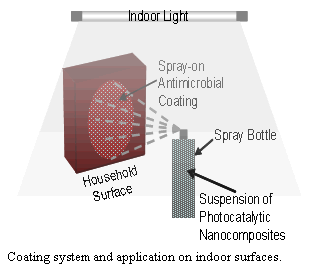Research Projects

Photocatalytic Nanocomposite Based Destruction of Microbes
R&D Team: Dr. Ben Koopman1,2, Dr. Brij Moudgil1,3, Dr. Vijay Krishna1,3.
1Particle Engineering Research Center, 2Department of Environmental Engineering Sciences, 3Department of Materials Science and Engineering.
Opportunity and Impact: Surfaces of windows, walls, tables, carpets etc. in buildings are repositories of bacterial and fungal spores, which cause nosocomial infections and allergy and respiratory problems such as asthma. The Center for Disease Control and Prevention (CDC) Summary Health Statistics for U.S. Children state that nine million U.S. children under the age of 18 have been diagnosed with asthma. Asthma is now recognized as the leading cause of school and work absences. Current research suggests that controlling environmental asthma triggers such as allergens and air pollutants would substantially reduce asthma in children. Common alcohol or hypochlorite disinfectants are ineffective against spores. Costs for replacement of contaminated surfaces in heavily impacted homes have ranged up to $5,000 per household. Photocatalytic technology is an attractive approach for controlling environmental pollutants because of the following characteristics:
- Use of photocatalyst eliminates need for chemical disinfectants and toxic byproducts
- Microbes are completely mineralized, thus eliminating allergens
- Solar energy or lamps can serve as the excitation source
 Project Description: Development of a suspension based product that can be spray applied to surfaces for destruction of common indoor microbial allergens. The suspension will consist of photocatalytic nanocomposites as active ingredient and the mechanism of inactivation will be solar UVA or visible light photocatalysis.
Project Description: Development of a suspension based product that can be spray applied to surfaces for destruction of common indoor microbial allergens. The suspension will consist of photocatalytic nanocomposites as active ingredient and the mechanism of inactivation will be solar UVA or visible light photocatalysis.
The photocatalytic suspensions developed in the proposed research will meet the following criteria:
- Destroy microbes that settle, migrate to, or grow on surfaces.
- Do not alter the texture and color of underlying surfaces at effective concentrations.
- Active under light from windows or lamps.
An approach is taken that improves the efficacy of photocatalyst at low concentrations by addition of a novel enhancer—polyhydroxy fullerenes (PHF). Advantages of PHF are: (1) the photocatalytic nanocomposites are easily synthesized through self-assembly, avoiding any need for chemical reaction; (2) concentration of PHF employed is 10-100 times lower than other reported enhancers (e.g., metals, dye); (3)PHF is non-toxic and also used for therapeutics.
The funding will give the research team the capabilities to achieve the following commercialization-critical milestones: (1) understanding of the parameters affecting performance of the nanocomposite coating in terms of antimicrobial activity, durability and appearance; (2) optimization of the nanocomposite formulation under solar UV; (3) optimization of performance under simulated indoor environment. These capabilities could ultimately enable development of technology for permanent coatings (e.g., paints) that are self-cleaning and antimicrobial.